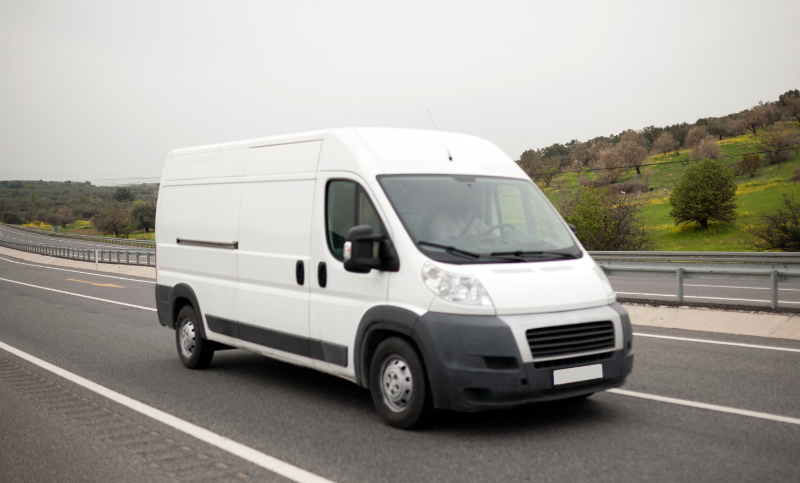Are you planning to drive a van for the first time? Whether it’s for personal use or work, driving a van requires a different set of skills compared to driving a regular car. This comprehensive guide will take you through everything you need to know about driving a van. We’ll start with an introduction to van driving and what makes vans unique. Then, we’ll dive into the step-by-step process of driving a van, covering important topics like navigation, shifting gears, speed control, turning corners, and more. Additionally, we’ll discuss important safety considerations, such as watching out for blind spots and securing your load properly. So if you’re ready to hit the road in a van, let’s get started!
Introduction to Driving a Van

Driving a van can be a different experience compared to driving a car. Vans tend to be larger and heavier, which means they may require more space and time to manoeuvre. Before getting behind the wheel of a van, it is important to familiarize yourself with its dimensions and handling characteristics. Take some time to practice driving in an open area to get a feel for the van’s acceleration, braking, and turning capabilities. Additionally, be mindful of blind spots, as vans often have larger blind spots compared to cars. By taking these factors into consideration and practising safe driving habits, you can confidently navigate the roads in your van.
What Kind of Vehicle is a Van?

A van is a type of vehicle typically used for transporting goods or passengers. Vans can come in a variety of sizes, from small cargo vans to large passenger vans. Businesses often use them to transport products or employees and families to transport large groups of people or belongings.
Vans generally have a boxy shape and tall ceilings, which makes them ideal for hauling cargo or passengers. They typically have sliding doors on the side and rear, and some have rear windows as well. Vans usually have either front-wheel drive or all-wheel drive; many are available with four-wheel drive for off-road use.
While vans are often thought of as workhorses, they can also be quite comfortable and even luxurious. Many newer vans feature amenities like heated seats, infotainment systems, and plenty of legroom. So whether you need a van for work or play, there’s sure to be one that’s perfect for you.
How to Drive a Van?

Assuming you know how to drive a car, driving a van is not much different. Here are some tips on how to drive a van:
1. Know how you’re getting from A to B
Planning your route in advance is essential for a smooth and efficient journey. Utilize navigation tools or maps to avoid getting lost or taking wrong turns. Consider the traffic conditions and choose the best time to travel to minimize delays. Familiarize yourself with alternative routes in case of unexpected road closures or detours. Stay alert and pay attention to road signs and signals for safe and accurate navigation.
2. Getting in gear
To get started with driving a van, it’s important to familiarize yourself with the gear shift and understand the different gears. Practice shifting smoothly between gears to avoid any jerky movements. Remember to engage the clutch pedal fully before changing gears, and gradually release the clutch pedal while applying gentle pressure on the accelerator to get the van moving. As you gain confidence, you can experiment with shifting at different RPMs to find your most comfortable driving style.
3. Watch your speed
When driving a van, it is essential to maintain a moderate and safe speed. Excessive speed increases the risk of accidents and makes it harder to control the vehicle. Always obey the posted speed limits and adjust your speed based on road conditions. You can also improve fuel efficiency by maintaining a steady and consistent speed. Remember to drive at a speed that allows you to control the van fully.
4. Watch out for the roof
Vans have higher roofs compared to regular cars, so it’s important to be mindful of low-hanging structures like bridges and parking garages. Before driving, ensure the van’s roof is clear of any excess cargo that could fly off while driving. Choose parking spots with ample overhead clearance to avoid roof damage. Exercise caution when entering underground parking lots or drive-thru areas with height restrictions. Regularly check the roof for signs of damage or leaks to ensure a safe driving experience.
5. Take care when turning corners
When driving a van, taking extra precautions when turning corners is important. Approach corners at a slower speed to maintain control and prevent tipping. Use your side mirrors to check for any obstacles or pedestrians before turning. Take wider turns to accommodate the van’s larger size and prevent hitting curbs or other vehicles. Signal early and clearly to indicate your intentions to other drivers. Practice turning in an open space to get comfortable with the van’s turning radius. Remember, safe cornering is essential for a smooth and secure drive.
6. Consider the weather
Weather conditions can significantly impact the handling and safety of driving a van. Whether it’s heavy rain, snow, or strong winds, these elements can make driving a van more challenging. During inclement weather, adjusting your driving speed accordingly and increasing the following distance is essential to ensure safety. Be mindful of slippery road surfaces and reduced visibility, and stay updated on weather forecasts to plan your route and avoid hazardous conditions. By considering the weather, you can enhance the safety of your van’s driving experience.
7. Driving a fully loaded van
Driving a fully loaded van requires some adjustments to your driving style. Since fully loaded vans have increased weight, you’ll need to allow for longer braking distances and slower acceleration. It’s crucial to distribute the weight to maintain stability while driving evenly. Additionally, be cautious of the van’s height and width, especially in tight spaces or low-clearance areas. Practising defensive driving techniques will help you anticipate challenges that may arise while driving a fully loaded van. Adjusting your driving style is essential to ensure a safe and comfortable journey.
8 Load the van securely and evenly
To ensure the safety of your cargo and maintain stability while driving, it is important to load the van securely and evenly. You can prevent any shifting during transportation by securing the load with straps, bungee cords, or tie-downs. Additionally, evenly distributing the weight throughout the van helps maintain balance and stability. Be mindful of weight distribution to avoid overloading one side of the van, which can affect its handling. It is also crucial to check the van’s maximum load capacity and adhere to it for safe driving.
9. Be aware of blind spots
Blind spots in a van are larger compared to regular cars, so it’s important to exercise extra caution. Always check your mirrors and look over your shoulder before changing lanes or making turns. Utilizing blind spot mirrors or installing aftermarket blind spot detection systems can further enhance visibility. Remember that blind spots can vary depending on the size and model of the van, so familiarize yourself with your specific vehicle. When merging or passing other vehicles, exercise additional care to ensure you’re aware of any potential blind spots.
10. Take a friend to help you park
Taking a friend along when parking a van can be truly valuable. Not only do they provide an extra set of eyes and assistance, but they also help you navigate tight spaces and avoid potential obstacles. With their guidance, you can easily manoeuvre difficult angles, ensuring the safety of your van and others around you. Moreover, having someone outside the van offers a different perspective and enhances your overall visibility. A friend’s advice and support during the parking process can make all the difference.
How to Turn on the Van and Enable the Safety Features?

Turn the ignition key or press the start button to start the van. Ensure that all safety features, including seatbelts, airbags, and stability control systems, are enabled. Familiarize yourself with the locations of the controls for these safety features, such as the seatbelt buckle and airbag indicators. Before driving, make sure all passengers have their seatbelts securely fastened. If your van has a stability control system, understand how it works and how to enable or disable it if needed. Always follow the manufacturer’s instructions for operating the van and its safety features.
Conclusion
To drive a van safely and confidently, it is essential to familiarize yourself with the vehicle and follow some basic rules of the road. From planning your route to loading the van securely, taking care of blind spots, and adjusting your driving style according to the weather conditions, there are several factors to consider. Remember always to be aware of your surroundings and take extra precautions when turning corners or parking. By following these guidelines, you can ensure a smooth and safe driving experience in a van. So, buckle up, start the engine, and confidently hit the road!









